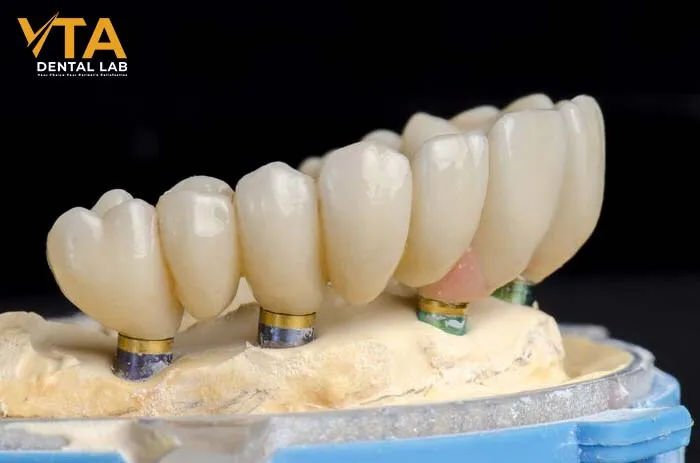What is an implant teeth bridge? Advantages and Workflow
An implant teeth bridge is a highly effective solution for replacing missing teeth, offering a perfect blend of stability, durability, and aesthetics. Supported by dental implants, this bridge provides a secure and natural-looking restoration that improves oral function and appearance. Keep reading to find out more about getting an implant teeth bridge.
What is an implant teeth bridge?
An implant teeth bridge is a dental restoration used to replace multiple missing teeth by anchoring an artificial bridge to dental implants. Unlike a traditional bridge that relies on adjacent natural teeth for support, an implant-supported bridge is secured directly to dental implants surgically placed in the jawbone.

Implant-supported bridges have three main parts:
- Dental Implants: Titanium posts are surgically placed into the jawbone to act as artificial tooth roots.
- Abutments: Connectors that attach the bridge to the implants.
- Dental Bridge: A custom-made prosthetic consisting of one or more artificial teeth (pontics) fused.
The Pros and Cons of the Implant Teeth Bridge
Here are the pros and cons of an implant-supported teeth bridge to help you understand its advantages and potential drawbacks:
The Pros of implant-supported bridge
- Improved Stability and Function: Implant-supported bridges are anchored directly to the jawbone, providing superior stability. This allows the patient to eat and speak without discomfort or slippage.
- Long-Lasting Solution: With proper care, implant-supported bridges can last 15 years or more, often outlasting traditional bridges. On the other hand, implants and bridges are made from materials like titanium and zirconia, which don’t decay like natural teeth.
- Bone Preservation: The implant post stimulates the jawbone, preventing bone resorption (shrinkage), which commonly occurs after tooth loss.
- Aesthetic Appeal: Custom-made to match the size, shape, and color of surrounding teeth, providing a seamless, natural look.
- No Impact on Adjacent Teeth: Unlike traditional bridges, which require the adjacent teeth to be filed down as anchors, implants support the bridge independently.

Cons of an Implant Teeth Bridge
- Longer Treatment Time: The entire procedure, including healing time after implant placement, can take several months (3-6 months or more).
- Maintenance and Care: While implants don’t decay, the surrounding gums and bone must be kept healthy with meticulous oral hygiene and regular dental visits to prevent peri-implantitis (inflammation around implants).
Why a patient might need a dental bridge
If a patient loses several adjacent teeth, it can directly affect the ability to chew and speak daily. Dental implants can solve these problems, including restoring the ability to speak and smile. Implants are permanently fixed to the jawbone and also help maintain the patient’s facial shape. At the same time, they also adjust and distribute the bite force during chewing.

How is an implant teeth bridge placed?
The process of placing an implant teeth bridge involves several stages, typically spanning a few months. Here’s an overview of the procedure:
Initial Consultation
The dentist evaluates your oral health, takes X-rays, and may use 3D imaging to assess bone density and determine the best implant placement.
Implant Placement Surgery
The area is numbed to ensure a pain-free procedure. Small incisions are made in the gum tissue, and the titanium implants are surgically placed into the jawbone at the predetermined positions.
Over the next 3-6 months, the implants fuse with the jawbone in a process called osseointegration, providing a stable foundation for the bridge.

Abutment Placement
Once osseointegration is complete, a minor surgery is performed to expose the implants and attach abutments (connectors) that will hold the bridge in place.
Bridge Fabrication
The dentist takes impressions of your mouth and then sends them to a dental laboratory to create a custom bridge that matches the size, shape, and color of your natural teeth.
A temporary bridge may be placed while the permanent one is being fabricated.

Placement of the Permanent Bridge
The custom-made bridge is fitted onto the abutments and adjusted for comfort, fit, and aesthetics. The bridge is securely attached to the implants, completing the procedure.
In Conclusion
Choosing the right solution for missing teeth is essential for restoring your smile and confidence. An implant teeth bridge offers a durable, natural-looking replacement that can improve both function and aesthetics. With proper care, it provides a long-lasting solution compared to traditional options.
Partnering with a professional dental lab is essential to ensure the best results. At VTA Dental Lab, we specialize in crafting high-quality implant-supported bridges with precision and advanced technology. Trust us to deliver restorations that enhance your patients’ smiles and confidence. Experience exceptional service and superior craftsmanship with VTA Dental Lab—your trusted partner for dental restorations